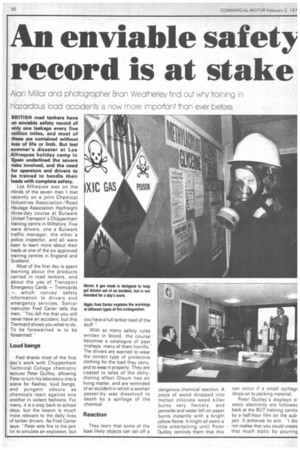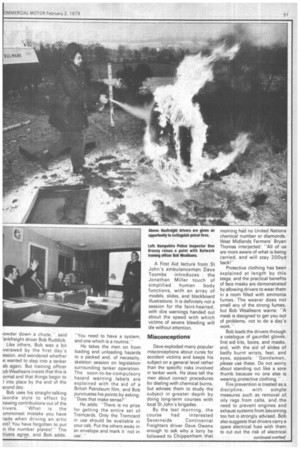An enviable safety record is at stake
Page 32

Page 33

Page 34

If you've noticed an error in this article please click here to report it so we can fix it.
BRITISH road tankers have an enviable safety record of only one leakage every five million miles, and most of these are contained without loss of life or limb. But last summer's disaster at Los Alfraques holiday camp in Spain underlined the severe risks involved, and the need for operators and drivers to be trained to handle their loads with complete safety.
Los Alfraques was on the minds of the seven men I met recently on a joint Chemical Industries Association / Road Haulage Association Hazfreight three-day course at Bulwark United Transport's Chippenham training centre in Wiltshire. Five were drivers, one a Bulwark traffic manager, the other a police inspector, and all were keen to learn more about their loads at one of the six approved training centres in England and Scotland.
Most of the first day is spent learning about the products carried in road tankers, and about the use of Transport Emergency Cards — Tremcards — which convey safety information to drivers and emergency services. Senior instructor Fred Carter tells the men: "You tell me that you will never have an accident, but this Tremcard shows you what to do. To be forewarned is to be forearmed."'
Loud bangs
Fred shares most of the first day's work with Chippenham Technical College chemistry lecturer Peter Guilley, allowing Peter to turn his laboratory into a scene for flashes, loud bangs, and pungent odours as chemicals react against one another in violent fashions. For many, it is a step back to school days, but the lesson is much more relevant to the daily lives of tanker drivers. As Fred Carter says: "Peter sets fire to his jam tin to simulate an explosion, but you have a full tanker load of the stuff."
With so many safety rules written in blood, the course becomes a catalogue of past. mishaps, many of them horrific.' The drivers are warned to wear the correct type of protective clothing for the load they carry, and to wear it properly. They are treated to tales of the dehydrating effect Oleum has on living matter, and are reminded of an accident in which a woman passer-by was dissolved to death by a spillage of the chemical.
Reaction
They learn that some of the least likely objects can set off a dangerous chemical reaction. A piece of wood dropped into molten chlorate weed killer burns very fiercely, and peroxide and water left on paper burns instantly with a bright yellow flame. It might all seem a little entertaining until Peter Quilley reminds them that this can occur if a small spillagf drops on to packing material.
Peter Quilley's displays 01 static electricity are followec back at the BUT training centre by a half-hour film on the subject. It achieves its aim. "I did not realise that you could create that much static by pouring iowder down a chute," said 'ankfreight driver Bob Ruddick.
Like others, Bob was a bit ,verawed by the first day's ession, and wondered whether le wanted to step into a tanker ab again. But training officer obWealleans insists that this is ormal and that things begin to t into place by the end of the econd day.
Bob uses his straight-talking ieordie style to effect by Irawing contributions out of the
Irivers. "What is the ommonest mistake you have nade when driving an artic init? You have forgotten to put ,n the number plates!'" The Irivers agree, and Bob adds: "You need to have a system, and one which is a routine.
He takes the men on from loading and unloading hazards to a packed and, of necessity, skeleton session on legislation surrounding tanker operation. The soon-to-be-compulsory hazard warning labels are explained with the aid of a British Petroleum film, and Bob punctuates his points by asking: "Does that make sense?"' He adds: "There is no prize for getting the entire set of Tremcards. Only the Tremcard in use should be available in your cab. Put the others away in an envelope and mark it 'not in use A First Aid lecture from St John's ambulanceman Dave Toombs introduces the Jonathan Miller touch of simplified human body functions, with an array of models, slides, and blackboard illustrations. It is definitely not a session for the faint-hearted, with dire warnings handed out about the speed with which victims of severe bleeding will die without attention.
Misconceptions
Dave exploded many popular misconceptions about cures for accident victims and keeps his subject on a general level rather than the specific risks involved in tanker work. He does tell the men about correct procedures for dealing with chemical burns, but advises them to study the subject in greater depth by doing long-term courses with local St John's brigades.
By the last morning, the course had interested Severnside Continental Freighters driver Dave Owens enough to ask why a lorry he followed to Chippenham that morning had no United Nations chemical number or diamonds. West Midlands Farmers' Bryan Thomas interjected: "All of us are more aware of what is being carried, and will stay 200yd back!''
Protective clothing has been . explained at length by this stage, and the practical benefits of face masks are demonstrated by allowing drivers to wear them in a room filled with ammonia fumes. The wearer does not smell any of the strong fumes, but Bob Wealleans warns: "A mask is designed to get you out of problems. not to do a day's work.
Bob leads the drivers through a catalogue of gauntlet gloves, first aid kits, boots, and masks, and, with the aid of slides of badly burnt wrists, feet, and eyes, appeals: "'Gentlemen, please use these. Do not worry about standing out like a sore thumb because no one else is wearing protective clothing."
Fire prevention is treated as a discipline, with simple measures such as removal of oily rags from cabs, and the need to prevent engines and exhaust systems from becoming too hot is strongly advised. Bob also suggests that drivers carry a spare electrical fuse with them to cut out the risk of electrical fires in their vehicles.
The course party, under Fred Carter's guidance, takes on the appearance of extras from Dr Zhivago when, clad in overalls, overcoats, and wellington boots, it heads to the back of Bulwark's sizeable premises for an exercise in the use of fire extinguishers. They are given the opportunity to put out petrol fires in a shallow tank and a lorry tyre. My own performance with the petrol tank would have been far from helpful in the event of a real emergency!
The three days' training is put into practice in a final classroom exercise in which a model of a traffic accident involving an Oleum tanker is set up and two teams are asked to draw up an emergency plan.
It is an interesting study of human behaviour, with stronger-minded individuals playing dominant roles, and, according to Bob and Fred, occasional displays of aggression and bad temper. Proper solution of the problem demands that the men use all of the subjects covered by the course, and that they present concise emergency plans.
Solutions
Fred Carter analyses their recommendations and argues points with the drivers to encourage them to justify their solutions. Both he and Bob find that drivers often make surprisingly sweeping assumptions about wind and weather conditions at the time of the accident.
With models out of the way again, Bob Wealleans winds up the course with a -pep talkencouraging the drivers to think more carefully about what they do, and to behave in a more professional manner.
And from listening to the opinions of some of the drivers on the course, I am sure that they will act more thoughtfully. Tankfreight's Gordon Jones's first day with his new employer was spent on the Hazfreight course, as he was employed before that on milk tankers. "It has been a great help to me, It makes me more aware of what to expect when I start to carry dangerous loads.
Despite years of experience with ammonia tankers, Bryan Thomas was convinced that his three days were well spent. "I am not sure if it makes you a better driver, because you are always learning, but it makes you think.
Hampshire Police force's Inspector Don Bracey felt that he had gleaned a considerable amount of useful knowledge from the course, and was prepared to have others in his force sent to learn the same points. Dave Owens felt one of the main points he had picked up was that the public should be encouraged to stay away from any spillage.
Bulwark is capitalising on the industry's acceptance of the £80 course as good value for money. It starts a Hazwaste course for the waste disposal industry on February 12, a Hazpet course for petrol transport contractors soon after Easter, and a Hazpak course for barrel and sackloads of chemicals soon after. Hazwaste will cost £88 for three days, while the others will be pegged at the same level as Hazfreight.
For anyone engaged in the transport of hazardous goods, these courses are extremely valuable, giving the driver not only a deeper insight into his work (and a personalised indentification card at the end of the course), but also the priceless advantage of being able to learn from the experience of fellow-drivers.
Hazardous goods transport has an enviable safety record in this country, and is determined to maintain if not improve upon it. As Bob Wealleans says: -Even that one spillage in five million miles is more than we want to have.




















































































































